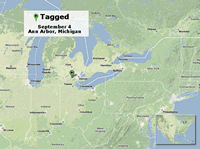Migration Update: September 25, 2008
Your Sightings! >>
Down the Atlantic, Along the Appalachians, and Crossing Out of
Canada!
Masses of monarchs traveled along Canada's northern Great Lakes
shores last week. The warm fall weather gave them time to travel before
cold temperatures trap them. Meanwhile, migration along the Atlantic Coast
is finally picking up, and monarchs are beginning to move down the Appalachian
Mountains in good numbers, too. The leading edge of the migration moved
very little in the Central Plains, but watch for the next cold front and
see what happens!
Migration
Pathways Appearing
The map of peak migration
sightings is beginning to reveal the pathways monarchs travel on their
way to Mexico:
- The north shore of Great Lakes Ontario and Erie are important migration pathways for monarchs that are leaving Canada. Why? It's dangerous for monarchs to cross large bodies of water unless the wind is just right. Therefore, large numbers of monarchs commonly travel along the shoreline instead. Last week's story about the tagged monarch showed the butterfly traveling just that way. Did you notice?
- The
shores of the Atlantic Ocean
Why do you suppose monarchs hug the Atlantic Coast during migration? (Think about that question, then read more.) One of the best migration-watching spots on the Atlantic Coast is New Jersey's Cape May Peninsula. For the 18th year, researchers there are counting monarchs daily. Last week's monarch-per-hour count was 28, compared to only 14 and 6 monarchs per hour the two weeks before. Visit Cape May website and see what you can learn from the 18 years of migration monitoring data they have collected. - The
Appalachian Mountains are a highway for migrating monarchs.
Special wind currents carry the monarchs aloft and give them a free
ride along the mountain ridges. Nancy Barrigar was watching in North
Carolina last weekend near Grandfather Mountain. How many monarchs per
hour did she see each day? Notice how much the migration can vary from
one day to the next in the very same place!
"We spent 1 ½ hours near Grandfather Mountain on Saturday, September 20th. Between 3:30 and 5:00 we counted 42 monarchs. We went back again on Sunday, September 21st. Between 1:00 and 5:00 we tallied 214 monarchs."
For
Your Journal: Sightings from Citizen Scientists
Monarchs
can only survive in places where their needs are being met. It's late
September now and many seasonal changes are occurring in the monarch's
habitat. Look for examples in this week's comments from citizen scientists.
In what ways is monarch habitat changing across eastern North America?
Where are the monarch's needs being met? Where is it becoming difficult
for monarchs to survive?
Found: Another tagged monarch! >> |
|
For
Your Journal |
|
How is monarch habitat changing, now that it's late September?
|
|
Distribution Map >> |
.
|
This Week's Map Questions >> |
Watch for monarchs that are flying in "directional flight," resting at overnight roosts, or refueling at flowers in fields, gardens, or roadsides.
- Geography and Migration: Why do monarchs hug the Atlantic Coast as they migrate?
- Geography and Migration: What's Happening Here? (South Atlantic Coastal Plain)
- Symbolic Migration: You're Invited to Send a Symbolic Monarch to Mexico!
- Collecting Data: How to Monitor Fall Migration
- Observing Fall Habitat: How is Monarch Butterfly Habitat Changing?
- Journey North for Kids: Monarch Butterfly Resources for Children
- More: Monarch fall lessons and teaching ideas
Monarch Butterfly Migration Updates Will be Posted on THURSDAYS: Aug. 28, Sep. 4, 11, 18, 25, Oct. 2, 9, 16, 23, 30, Nov. 6...or until the monarchs reach Mexico!
The Next Monarch Migration Update Will Be Posted on October 2, 2008.








